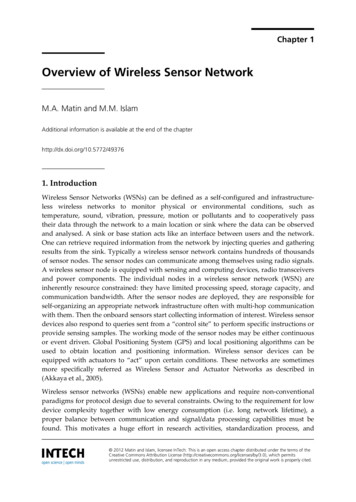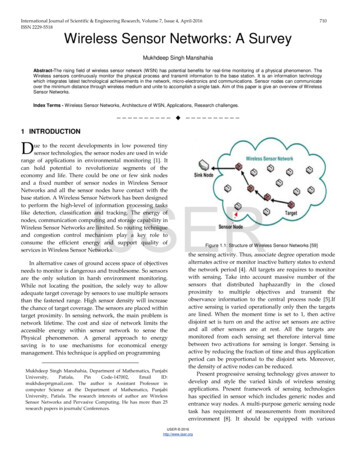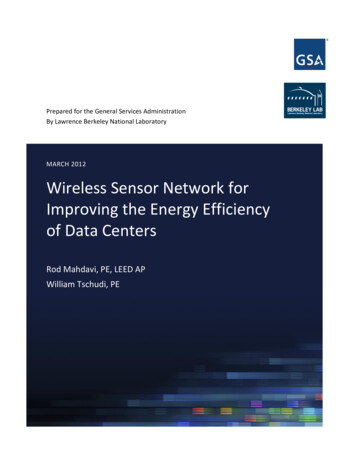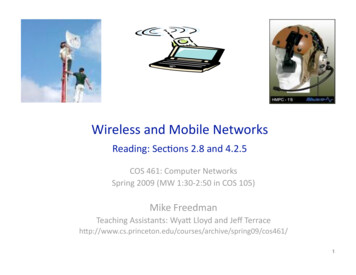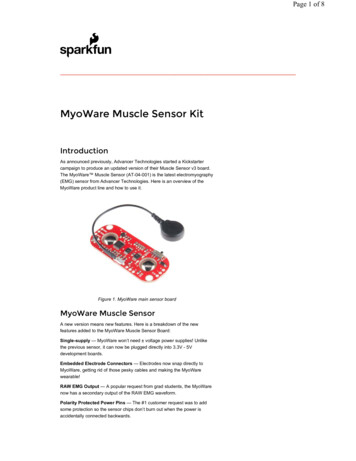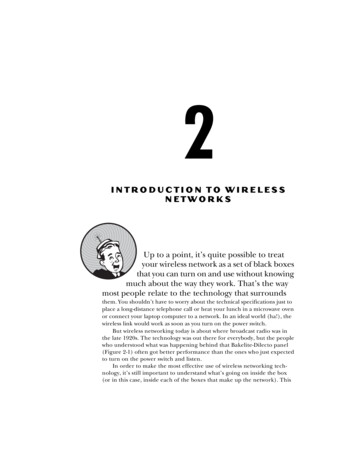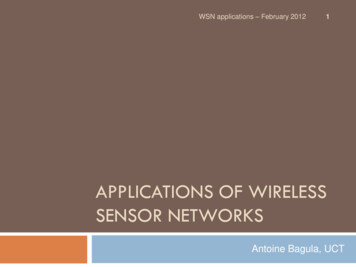
Transcription
WSN applications – February 20121APPLICATIONS OF WIRELESSSENSOR NETWORKSAntoine Bagula, UCT
Outline2Why Use WSNs Classification Sensor Usage WSN Applications Future WSN applications – February 2012
I. Why Use WSNs ?3PredictiveMaintenanceHigh-ConfidenceTransport andAsset TrackingEnergy SavingSmart GridIntelligentBuildingsImproveProductivityEnable NewKnowledgeEnhanced Safety &SecurityImprove Foodand H2OHealthcareSmart Home Interesting ApplicationsWSN applications – February 2012
Why Use WSNs ?4 Translate Sensing and Identification activities into ServicesWSN applications – February 2012
Why Use WSNs ?5 Embed, Network and Disseminate toprovide Services to different ClientsWSN applications – February 2012
II. Sensors Classification6 Readiness for field deployment: measures maturity for fielddeployment in terms of economic and engineering efficiency. Scalability: a sensor’s scalability to distributed environmentalmonitoring tasks require that the sensors be small and inexpensiveenough to scale up to many distributed systems. Cost: Sensors are deployed in thousands. It is expected that costwill drop but current generation sensors are still expensive to allowwide deployment. For water quality monitoring, physical sensors aregenerally more field-ready and scalable than chemicalsensors, which are, in turn, substantially more fieldready and scalable than biological sensorsWSN applications – February 2012
Sensors Classification7Sensor yTemperatureHighHighMoisture ContentHighHighFlow rate, Flow velocityHighMed-HighPressureHighHighLight Transmission (Turb)ChemicalBiologicalHighHighDissolved OxygenHighHighElectrical ConductivityHighHighpHHighHighOxydation Reduction Potential MediumHighMajor Ionic Species (Cl-, Na ) Low–MediumHighNutrientsa (Nitrate, Ammonium) Low–MediumLow–HighHeavy metalsLowLowSmall Organic CompoundsLowLowLarge Organic CompoundsLowLowMicroorganismsLowLowBiologically active contaminants LowLowWSN applications – February 2012
III. Sensors Usage8 Libelium study involving a total of 283 interestedusers in terms of sensors preferences. The usersinclude researchers and practioners (developers).The results are classified in the next 5 main fields: environmental, gas, physical, opticaland biometric.WSN applications – February 2012
Use of environmental sensors9 Sensors: Temperature, Humidity (soil,leaf,ambient), Soil moisture,Wind (speed and direction), Pressure, Leaf, Ph, Redox. Application: Precision agricultural applications are one of the most required inthe terms of temperature, humidity (soil, leaf, ambient) and wind(speed and direction). Ph and Redox sensors being demanded for water qualityWSN applications – February 2012
Use of physical sensors10 Sensors: accelerometer, presence, vibration, power, hall, ultrasound, water,sound, bend, flex, strain, stress. Application: Motion of any kind using accelerometers, vibration, and presencesensors . security applications are waiting to be deployed. world of objects: bend, flex, strain and stress sensors let know how eachobject is interacting with the world and monitorize its state.WSN applications – February 2012
Use of gas sensors11 Sensors: Co2, Co, CH4, O2, NH3, SH2, NO2, Pollution. Application. Organic gases (carbone) derived from the "live systems" such asrespiration in humans (CO2), animals (CH4) and combustion (CO)of vegetable elements (fire forest) are the most required sensors. Other toxic gases which can be found in animal farms (NH3,SH2) and the fabric and cars pollution gases (NO2) complete thelist.WSN applications – February 2012
Use of optical sensors12Sensors: Infrared, Sunlight, Radiation, Ultraviolet, colorApplication. Optical sensors to detect human presence through the IR spectrumare the most voted sensors in this area. Agriculture applications where the sun light, radiation and ultravioletsensors are required in order to measure the total amount of energyand light which is absorbed by the plants.WSN applications – February 2012
Use of biometric sensors13 Sensor types: Electrocardiogram ECG, Oximetry, Pulse, Fall, Sweat Application: Prevent a possible attack or the fall of a elderly person (using an accelerometer)by monitoring his heart pulse, rate and other heart activities. Used in combinationof SMS alarms using the GSM/GPRS module Requirements: a real time and redundant alarm system so that communication canalways be established.WSN applications – February 2012
IV. WSN Application Examples14 Disaster relief operations Dropsensor nodes from an aircraft over awildfire Each node measures temperature Derive a “temperature map” Biodiversity mapping Usesensor nodes to observe wildlifeWSN applications – February 2012
WSN application examples15 Intelligent buildings (or bridges) Reduceenergy wastage by properhumidity, ventilation, air conditioning(HVAC) control Needs measurements about roomoccupancy, temperature, air flow, Monitor mechanical stress afterearthquakesWSN applications – February 2012
WSN application examples16 Machine surveillance and preventive maintenanceEmbed sensing/control functions into places no cable hasgone before E.g., tire pressure monitoring Precision agriculture Bring out fertilizer/pesticides/irrigation only when andwhere neededMedicine and health carePost-operative or intensive care Long-term surveillance of chronically ill patients or theelderly WSN applications – February 2012
WSN application examples17Great Duck Island[UCB, 2002]WSN applications – February 2012
Great Duck Island18 Reference: “Wireless Sensor Networks for HabitatMonitoring”, A. Mainwaring, J. Polastre, R.Szewczyk, D. Culler, J. Anderson, WSNA (WirelessSensor Networks and Applications), Sep 2002Monitoring seabird nesting environment (Leach’sStorm Petrel)WSN applications – February 2012
Great Duck Island19WSN applications – February 2012
Great Duck Island20 Impacts of human presence on plants and animals Minimal disturbance is crucial while monitoringEspecially seabird colonies20% mortality of eggs due to a 15-min visitRepeated disturbance birds may abandonLeach’s storm petrels desert nesting burrows ifdisturbed in first 2 weeks of incubationNatural answer: wireless sensor networksWSN applications – February 2012
Great Duck Island21 Motivation: Life Scientists’ PerspectiveUsage pattern of nesting burrows over the 24-72hour cycle when one or both members of abreeding pair alternate incubation and feeding atseaChanges in burrow and surface environmentalparameters during the 7-month breeding seasonDifferences in micro-environments with and withoutlarge numbers of nesting petrelsWSN applications – February 2012
Great Duck Island22 Motivation: Sensor Networks PerspectiveApplication-driven approach better than abstractproblem statements Separate actual problems from potential onesRelevant versus irrelevant issuesDevelop an effective sensor network architectureLearn general solutions from specific onesWSN applications – February 2012
Great Duck Island23 Data Acquisition RatesPresence/absence data: using temperaturedifferentials General environmental parameters: Every 5-10 minEvery 2-4 hoursPopular vs unpopular sites: Every 1 hour, at the beginning of the breeding seasonWSN applications – February 2012
Great Duck Island24 Sensor network longevity: 9 months Solar power where possibleStable operation crucialSensors: light, temperature, infrared, relativehumidity, barometric pressureRemote data acquisition, management, andmonitoring over the Internet In-situ operations alsoWSN applications – February 2012
Great Duck Island25 Remarks on the Architecture Hierarchical networkSolar panel at gateways and base-stationIn-situ retasking possible Example: collect temperature beyond a certain threshold, noneed for all temperature readingsBase-station has satellite connectivityWSN applications – February 2012
Great Duck Island26WSN applications – February 2012
Great Duck Island27WSN applications – February 2012
WSN application examples28[Princeton, 2004]WSN applications – February 2012
WSN application examples29 ZebraNet: an application to track zebras on the fieldThe objective of the application is to gather dynamicdata about zebra positions in order to understandtheir mobility patterns.What are the motivations for the zebras to move?water? food? weather?How do they interact?The sensors are deployed in collars that are carried bythe animals.The users are the biologists.WSN applications – February 2012
WSN application examples30WSN applications – February 2012
WSN application examples31 Reference: “Deploying a Wireless Sensor Networkon an Active Volcano”, Geoffrey Werner-Allen,Konrad Lorincz, Matt Welsh, Omar Marcillo, JeffJohnson, Mario Ruiz, Jonathan Lees, IEEE InternetComputing, Mar/Apr 2006Tungurahua, EcuadorWSN applications – February 2012
WSN application examples32WSN applications – February 2012
WSN application examples33WSN applications – February 2012
WSN application examples34 Challenges Encountered Event detection: when to start collecting data? High data rate sampling Spatial separation between nodes Data transfer performance: reliable transferrequired Time synchronization: data has to be time-alignedfor analysis by seismologistsWSN applications – February 2012
WSN application examples35 Bridge MonitoringStructural health monitoring (SHM) is a sensor-basedpreemptive approachIn California, 13% of the 23,000 bridges havebeen deemed structurally deficient, while 12% ofthe nation's 600,000 bridges share the same rating.New York may be the first state with a 24/7wireless bridge monitoring system.Another application in India: Bri-MonWSN applications – February 2012
WSN application examples36Agriculturee.g., TU Delft DeploymentWSN applications – February 2012
WSN application examples37Smart AgricultureWSN applications – February 2012
WSN application examples38Smart AgricultureWSN applications – February 2012
WSN application examples39 Objectives: Using a combination of sensors such as humidity, temperature, and light,detect the risk of frost, possible plant diseases and find wateringrequirements based on soil humidity. manage crop cultivation to know the exact condition in which plants aregrowing from the comfort of your own home. control conditions in nurseries and closely monitor high performance ofdelicate crops, such as vines or tropical fruit, where the slightest changein climate can affect the final outcome determine the optimum conditions for each crop, by comparing thefigures obtained during the best harvestsWSN applications – February 2012
WSN application examples40Animal RearingWSN applications – February 2012
WSN application examples41 Objectives: Instala wireless sensor network near animals to helpoptimise their rearing conditions. Monitor the temperature of litters to keep it at suitablelevels; Measure levels of gases produced by livestock such asmethane (CH4), ammonia (NH3) and HydrogenSulphide (SH2); Control animals’ stress levels by monitoring flockrestlessness with vibration and movement sensors.WSN applications – February 2012
WSN application examples42Natural Environment ProtectionWSN applications – February 2012
WSN application examples43 Objectivesdetect and prevent forest fires. Detect flames, heat andgases that help to identify the molecules of chemicalcompounds generated during combustion (CO and CO2).With GPS, allow the exact geolocation of the nodes. Prevention. After installing the WSN, the network can alsoacquire the daily values for temperature and relativehumidity in order to determine the likelihood of a fire ineach zone under surveillance. Alarm. Send an alarm indicating the status of the fire orthe probability level and the area. WSN applications – February 2012
WSN application examples44 Smart CitiesWSN applications – February 2012
WSN application examples45 Objectives Noise pollution to prevent common environmental problem affectingboth the quality of life and health.Atmospheric pollution in the form of gases such as CO2 and NO2or dust – to prevent threats to the health of urban dwellers thatcause respiratory diseases.Garbage levels to promote public health by enabling timelygarbage collection.structural health monitoring – to enable public safety by ensuringthat the largest structures found in cities including buildings, bridgesand roads are sound.Traffic and parking management - to minimize emissions and avoidunnecessary journeys.WSN applications – February 2012
WSN application examples46Radiation SensorNetworkWSN applications – February 2012
WSN application examples47 Objectives Radiation prevention - help authorities and security forces tomeasure the levels of radiation of the affected zones withoutcompromising the life of the workers.Geigger counting - each node acts as an autonomous andwireless Geiger Counter which measures the number of countsper minute detected by the Geiger tube and send this valueusing ZigBee and GPRS protocols to the control point.WSN applications – February 2012
WSN application examples48WSN applications – February 2012
WSN application examples49 The Prevention and Control Radiation Sensor Network. It is formed bydozens of sensor devices deployed in the surroundings of the nuclearpower plant and reaching the closest cities. Sensor nodes are installed instreet lights and trees and take power from the internal battery which, atthe same time is recharged using a small solar panel giving unlimitedlifetime to the system. The nodes read the value of the Geiger tubeduring an specific time interval and calculate the number of counts perminute which are generated by the interaction of the radioactiveparticles.Emergency radiation sensor network. If a radiation leakage occurs in aplace where there is not a previously installed radiation sensor network,an emergency deployment can be done in just a couple of hours. Securitycorps just need to spread the sensor nodes on the ground at certainplaces.WSN applications – February 2012
WSN application examples50Smart ParkingWSN applications – February 2012
WSN application examples51 Objectives Traffic monitoring - to calculate the average speed of the vehicles which transit over a roadway by taking the time markat two different points.Flow and congestion control. – Understand the flow andcongestion of vehicular traffic for efficient road systems incities: reduce journey times, reduce emissions and save energy.WSN applications – February 2012
WSN application examples52Two different types of radio are connected at the same time: a Bluetooth radiois used as a sensor to make inquiries and detect nearby devices, while theZigBee radio sends the information collected using its multi-hop capabilities.WSN applications – February 2012
WSN application examples53Smart MeteringWSN applications – February 2012
WSN application examples54 Objectives Traffic monitoring - to calculate the average speed of the vehicles which transit over a roadway by taking the time markat two different points.Flow and congestion control. – Understand the flow andcongestion of vehicular traffic for efficient road systems incities: reduce journey times, reduce emissions and save energy.WSN applications – February 2012
WSN application examples55 Objectives: Measurement of the following keyparameters:Electric current Water flow Weight of materials and goods Liquid level Distance by ultrasounds Distance and displacement of an object WSN applications – February 2012
WSN application examples56Applications include: Electric consumption Water consumption Pipe leakage detection Liquid storage management Tanks and silos level control Supplies control in manufacturing Industrial Automation Agricultural IrrigationWSN applications – February 2012
WSN application examples57[CodeBlue: Harvard]WSN applications – February 2012
V. Future58WSN applications – February 2012
Future: mobiles as sensors?59WSN applications – February 2012
Future: mobiles as sensors?60WSN applications – February 2012
Future: mobiles as sensors?61WSN applications – February 2012
Future: mobiles as sensors?62Mobile devices can bridge the visibility gapleft by professional weather stations.WSN applications – February 2012
Future: mobiles as sensors?63 Personalized estimates of environmental exposure andimpactPEIR, the Personal Environmental Impact Report, is a newkind of online tool that allows you to use your mobilephone to explore and share how you impact theenvironment and how the environment impacts you.WSN applications – February 2012
Rempod64WSN applications – February 2012
Conclusion65 Work done on WSNs, both simulation and Testbedhas revealed that It’s an interesting, complex, newtechnology.However, we have been witnessing poordeployment resulting from many causes: slowadoption ? Lack of standardization ? Need formore applications ?WSN applications – February 2012
Credits66 Credits for the slides go to: Libelium MarcoZennaro Holger KarlWSN applications – February 2012
Thanks67Antoine SN applications – February 2012
Reference: “Wireless Sensor Networks for Habitat Monitoring”, A. Mainwaring, J. Polastre, R. Szewczyk, D. Culler, J. Anderson, WSNA (Wireless Sensor Networks and Applications), Sep 2002 Monitoring seabird nesting environme

